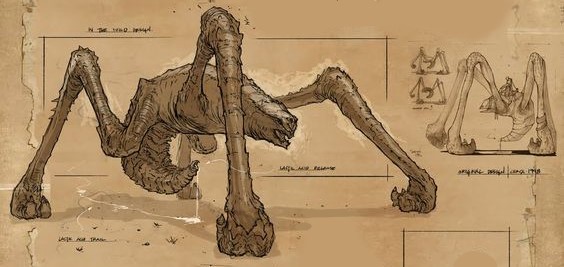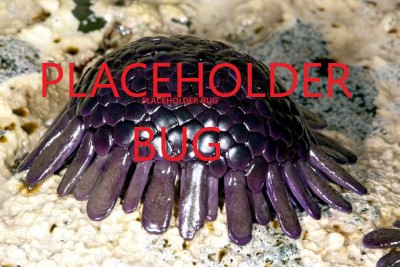Whatever you do, don't get underfoot of one of the Striders.
The Goa Striders are great, lumbering beasts of the Surface who make their home among arctic tundras and frozen glaciers. They stand much taller than a human, with long legs and powerful claws that lets it cross over hills and climb mild inclines. They are the animal used by the
Phtangi Nomad and occasionally by other settlements who live close to the frozen lands of the Surface.
Description
The striders are towering, four-legged creatures with rough, hard skin and a shell-like abdomen that curls beneath their torso. Their heads have deeply set eyes and a sharp beak-like maw filled with teeth. They have surprisingly long tongue which they use to manipulate food with, almost as a hand. The body is squat and compact, while the legs are comparatively thin but very long and end in brutally powerful claws that can smash things to pulp. While walking, the claw are curled inward but the Strider is capable of grasping and tearing with it.
When resting, mating or eating, the Goa will lower itself backwards and curl two legs underneath itself then either use one or both front legs to support itself or handle food.
The claw of the Goa Striders are their most potent weapon. The skin on the end of the arm is dense and the bone solid. The creature use the end of it like a hammer, smashing through glacier ice or battering foes into pulp.
Behavior
Opportunistic omnivores, the main thrust of the Strider's diet is the
red algae that bloom in the cold and frozen places of the surface. This is supplemented by almost anything else that they can get their crushing claws on, from small mammals to other vegetation. The most common method of hunting meat is for the Strider to pummel the den of a prey animal until it is either buried or tries to escape, at which point the Strider tries to smashed them. They are not beyond adding scavenge to their diet and will feast on any corpse they might come across - including human corpses.
Some Goa walk the same trails that they have wandered for generations, creating so-called strider-paths across the land. Nomads and Surface explorer know that these trails are usually safe from regular predators or Blight. The most obvious danger of following a strider-path are the Goa Striders themselves.
Goa Striders are nomadic, always moving in search of fresh blooms of red algae and other food. They are not very fast, but can walk at a steady pace for days should it be required. When harried by predator, the Goa Strider will close ranks around the young while young males without males aggressively go after the attackers - a behavior sometimes used to isolate and devour them. The Goa are not easy prey to take down, however.
Life Cycle
Mating among the Goa take place every year or two. Males engage each other in violent duels over mating rights, with every male laying claim to three or four females. These duels sometimes end in broken bones and crushed shells, leading to a slow and painful death for the defeated. In other instances, a defeated male will immediately attempt to challenge another and be broken down by a string of defeats. Defeated males remain with the herd but remain towards the back of the trail while the mated couples lead.
Dying or crippled Goa are left behind, though starving herds sometime stop to devour them. On the Surface, little goes to waste - even your own.
The Goa give birth to live young that are capable of walking with the rest within the hour. It takes several years for them to grow to their adult form and they don't begin to challenge for mating rights until they are around five or six years old. The oldest recorded Goa was over twenty years old, but most succumb much earlier than that from the harsh conditions or deadly predators of the Surface.

by Feng Zhu
Striding Across the Surface
They're not the fastest or smartest, but they get us where we need to be.
Despite the dangers, the Goa Striders are sometimes hunted by humans for the meat and the hide. The long bones are good for use in construction in a land without
Cave-Capped Hatter. Among the few settlements on the frozen lands of the Surface, some have learned to tame the dangerous Striders into powerful beasts of burdens, capable of carrying great loads or many tiders. The Goa Striders are not domesticated however; they are wild beasts coaxed into obedience. It is not uncommon for the occasional person to get flattened by their claws when they pester the animals.
The most notable riders of the Goa Striders are the
Phtangi Nomad, one of only three people who make their lives on the dangerous surface. This number is reduced to two if
the Exiled are not considered, as they would rather not be there.





Comments